The chapel near the main entrance of Cristo Rey St. Martin notably differs from the rest of the building in its aesthetic. The altar and ambo are custom-designed and built. The large cross that arches across the ceiling is framed by sustainable bamboo wood. The processional cross and tabernacle were specially crafted with the Cristo Rey logo. Recently, another unique feature was introduced to the space: seven mosaic scenes adorn the chapel walls.
These mosaics are a symbol of both modern technology and traditional methods of production, each with historical origins behind them. The images were chosen and then edited with AI to generate the tile format and customization. After the artwork was created the mosaics were then produced in Lebanon during the current Israeli-Palestinian conflict.
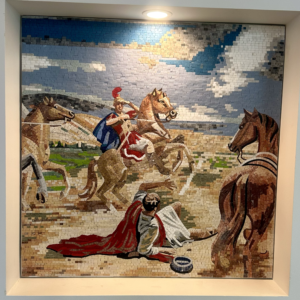
Mosaic #1: The moment St. Paul is blinded by God in front of a Roman soldier.
Preston Kendall explains that “much like restaurants have a signature dish, Father Foley used to say that the Cristo Rey movement had a signature gospel story… that is when Saul becomes St. Paul and is blinded by God’s light and told to go into the city and do what he must do.” As such, the CRN founders fulfilled what ‘they must do’ in the Pilsen neighborhood of Chicago – they knocked on the doors of the community members and asked what they needed. The community unanimously agreed that a college preparatory high school was of greatest need, and the first Cristo Rey school was born.
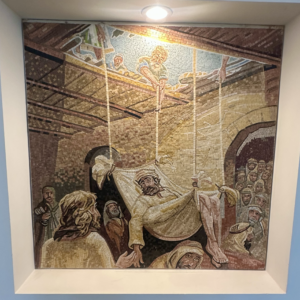
Mosaic #2: Luke 5:19, in which a paralyzed man is lowered through the roof of a crowded house for Jesus to forgive and heal.
Jim Dippold, Director of Campus Ministry, states that “the creative problem-solving of the man’s friends is reflected in our own stories and life challenges. If something seems difficult or impossible, much like starting a Cristo Rey school, the community will always find a way with grit and perseverance.”
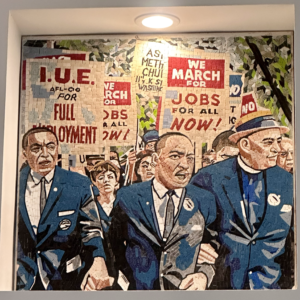
Mosaic #3: Martin Luther King Jr.’s March on Washington protest, aligning with our commitment to social justice.
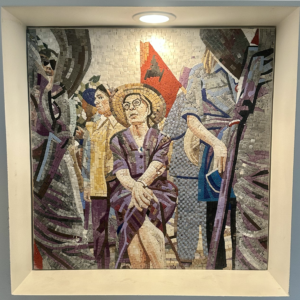
Mosaic #4: Dorothy Day, co-founder of the Catholic Worker Movement.
The scene captures her moments before being arrested at a United Farmworker protest, fighting for better wages and working conditions in California’s grape fields. She symbolizes our modern interpretation of the Mass for the Feast of St. Joseph the Worker and embodies “faith in action,” Dippold explains.
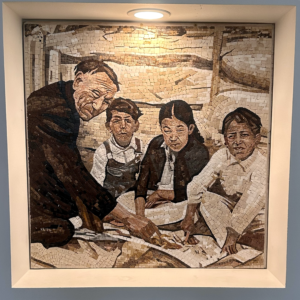
Mosaic #5: Nicholas Black Elk, a Lakota medicine man, and Catholic catechist who worked with the Jesuits, is featured in this scene teaching young children the Catholic Faith.
Black Elk was a medicinal healer who became Catholic in the early 1900s and is currently in the process of canonization. This is CRSM’s homage to the connection that Cristo Rey St. Martin has with Mahpiya Luta High School on the Pine Ridge Indian Reservation, South Dakota, and shows us a path of interreligious dialogue and authentic inculturation.
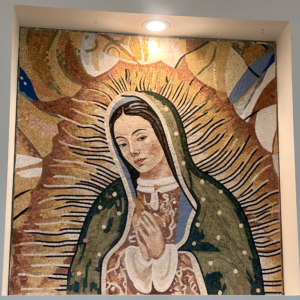
Mosaic #6: Our Lady of Guadalupe
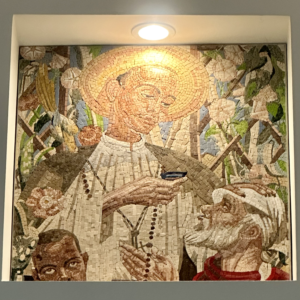
Mosaic #7: Young St. Martin de Porres
The feast day Masses to celebrate Martin and La Virgen are especially significant for our CRSM community. The school is named after St. Martin, and the mosaic shows a young St. Martin, aligning him more closely with the CRSM student population. Our Lady of Guadalupe is a cornerstone of Mexican Catholicism, and this mosaic is meant to resonate with our students, who are primarily of Mexican descent and hold cultural significance.
To complete this unique feature of the chapel, there will be a Bible verse accompanying each mosaic that holds its story and message. These will most likely be installed this spring.

